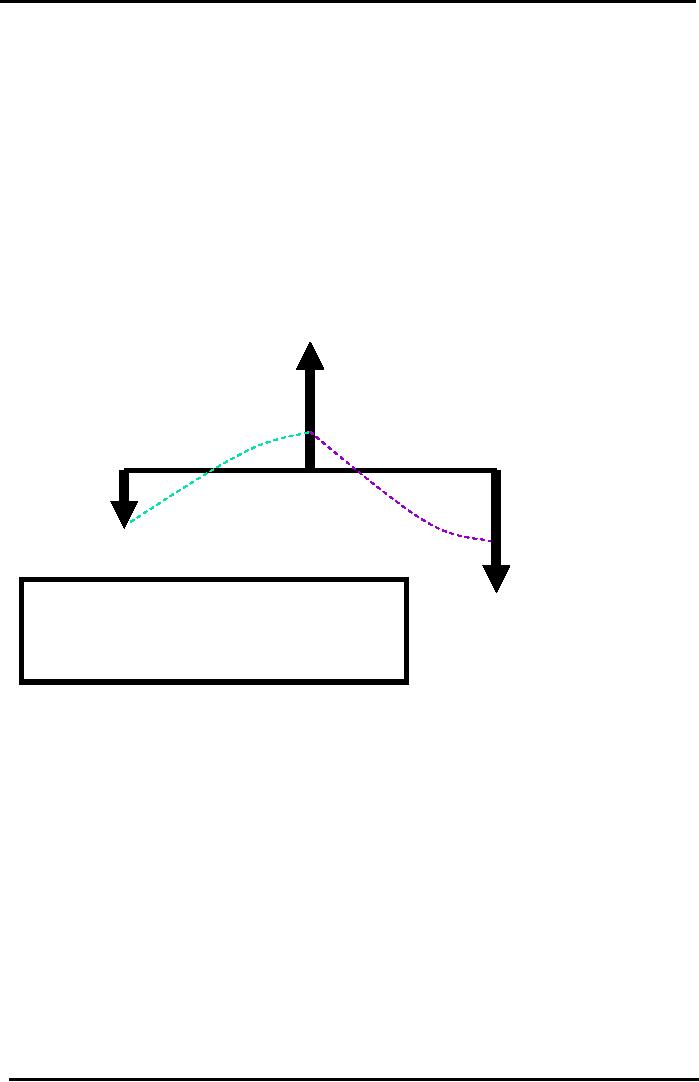 |

Financial
Management MGT201
VU
Lesson
10
PROJECT
CASH FLOWS, PROJECT TIMING,
COMPARING PROJECTS, AND
MODIFIED
INTERNAL
RATE OF RETURN (MIRR)
Learning
Objectives
After
completing this lecture, you
would be able to understand
�
Cash
flows relevant to NPV and
IRR
�
Project
timing on the cash flows
relationship
�
Steps
involved in preparing pro
forma cash flow
statement
�
Project
options
�
Problems
with IRR
�
Modified
Internal Rate of
Return
�
Problems of
comparison among projects of unequal
life
Today,
we are going to talk about
project cash flows, along
with the concepts of net present
value
(NPV)
and internal rate of return
(IRR), as they relate to the
project cash flows. NPV
and IRR are
important
and widely used techniques of
evaluating investment in real
assets. Before going into
details
of
these techniques, one must have a clear
understanding of what these
real assets are.
Real
assets projects may also
include entire businesses.
Investors have the option of investing
in
running
businesses, which are also a
collection of assets. The
way a project can be
evaluated using the
IRR
and NPV techniques, the cash
flows being generated from a
business can also be
evaluated in the
same
manner.
The
actual NPV and IRR for
real assets are not
very easy to calculate despite having an
easy
formula,
because the inputs used in the
formula are only estimates.
Cash flows, the basic input
is based
on
forecasts, hence majority of
errors that may take place
in calculating the actual NPV or IRR of
any
project
may be because of forecasting errors.
The next important challenge
is to assess or forecast the
anticipated
life of the business, which
could only be based on an
educated guess. Although,
you might
have
studied in financial accounting
about the perpetual concern, however, in
reality businesses have
finite
life. Another important
input is the discount rate. Picking the
right discount rate is not an
easy task
either.
However, we will talk more
about discount rates when we
would discuss the concept of
risk. All
these
factors combined together make
the calculation of NPV very
difficult.
Let
us begin with a relatively
simple formula for
calculating net incremental after
tax cash flows.
Net
incremental after tax cash
flows = net operating income +
depreciation +
Tax
savings from depreciation + net working
capital + other cash
flows
�
Net
operating income is obtained from the
income statement
�
Depreciation
is added back since it is a non-cash
expense
�
Net
working capital requirements for the
project as estimated are
also added
�
Other
cash flows which are
associated with NPV
Other
Cash flows relevant to the NPV of
the project
Broadly
speaking, these other cash
flows can be categorized into three
types
1.
Opportunity costs relevant to
the cash flows of the
project
Suppose
you are to invest in a new
project, a small production
unit with 4 weaving looms.
You
would
also need to have a piece of land where
the machinery would be installed.
Suppose
further,
that you already have that
piece of land. While calculating the
NPV for the project,
you
would
have to include the value of the land
that you are using.
Although you are not
buying that
land,
but that land has a
certain market value. You
could have sold that land at
the market price
and
by not doing so you are
incurring an opportunity
cost.
2.
Cash flows associated with
externalities
Externalities
in financial terms may be
defined as incidental cash
flows that arise because of
the
effect
of new project on the existing or
running business. For
instance, if a company adds a
new
product
to its produce line, the launching of the
new product can adversely
affect the sales
revenue
of the existing product line.
This phenomenon of competition among the
brands of the
same
company is also known as cannibalization.
When an entrepreneur is embarking on a
new
project,
he might either hurt or
increase the sales of the existing
products and that is an
externality.
While calculating the net incremental
after tax cash flows, the
incremental effect of
these
externalities, whether negative or
positive should be included in the
calculation.
50

Financial
Management MGT201
VU
3.
Sunk costs:
Sunk
costs need to be excluded
while calculating the incremental
cash flows. Sunk
costs
are the costs that have
already incurred in the past.
Whether you decide to invest
your
money
in the new project or not, the sunken
costs cannot be recovered. For instance,
if a
company
has purchased an import/export license
and a few years after the company
decides to
export
a certain commodity, the cost
incurred to purchase the license would
not be included in
the
cash flows. Whether the company
decides to undertake the new
export project or not,
the
license
fee cannot be recovered.
Timing
of the projects:
The
next important issue that we
need to look at is the different times in
which project or
business
cash flows have incurred.
Broadly speaking, there are three
phases.
1.
Initiation of the project, the time of
investment
2.
Life of the project
3.
Termination of the project
Time
of investment:
Time
of business refers to the initiation time
when the initial cash
outflow occurs. In addition
to
the
investment in the fixed assets,
you may also have net
working capital requirements or
mobilization
requirements
to get the project started. You can add
these two types of initial
cash outflows since
they
are
occurring at the same point in
time. You might also have to
subtract any tax paid on the
sale of old
assets
to get a net figure for the initial
cash outlay. As we discussed
earlier, we need to invest in
new
assets
if the old assets become
less productive. These old
assets, despite losing their
productivity have
some
market value at which they
can be disposed off. If the
market value of the project is
higher than its
book
value, the company earns as gain on the
sale of the asset, which may
be taxable1.
Life
of the project:
This
second phase encompasses a
major duration since it is
concerned with the cash
flows that
occur
during the life of the project.
The relevant cash flows
for the period would be the
operating cash
flows,
in the form of cash receipts
from sales revenue and other
income, as well as cash
expenses or
payments
in the form of operating, marketing and
administrative costs. It is important to
keep in mind
that
all these revenues and costs
would be seen on a cash
basis. We would also need to
take into account
if
there are any tax savings
that are coming about
because of showing increased
depreciation. The
change
in depreciation takes place as the
new assets are included in
the business and these new
assets
are
usually depreciated at an accelerated
rate in comparison to the old replaced
assets, which were
being
depreciated
at a low rate in the final year of
their useful life. The
amount of depreciation could
also
increase
if the new asset has a
high price, the amount of depreciation
charged to the asset would
also be
high.
Since depreciation is a non-cash expense,
it has to be added back to the net profit
to get the cash
flows.
If the new asset has replaced an
old one, the difference between the
depreciation of the two
would
be added to the cash
flows.
Termination
of the project:
Termination
of the project refers to the period when
the project life ends. At
this time, we need
to
take into account the
salvage value of the project
assets, the price at which the
assets can be sold
out.
Selling
an asset results in a cash
inflow--represented by salvage value. In
addition, you would
also
recover
the working capital that you
have invested in the business at the
beginning. This would
be
another
cash flow because of
liquidating accounts receivable
and other accrued
assets.
Steps
involved in preparing estimated
cash flow statement:
Cash
flow statement is a consolidated
statement of changes in financial
position. Following are
the
steps
involved in preparing a cash
flow statement.
�
Net Operating Income
(from Performa P/L)
�
Add back Depreciation (non-cash
expense)
�
Add Additional Net
Working Capital
Required
�
Subtract Additional Investments in Fixed
Assets
�
Add Any Tax Savings from
Change in Depreciation
�
Add Any Cash from Sale
of Assets at Salvage Value
1
In
certain countries, like
Pakistan, capital gains are
not taxed at all
51

Financial
Management MGT201
VU
�
Add
Any Tax Savings from Gain on
Sale of Assets
The
following example would help
you in understanding the composition of a
cash flow statement
based
on the pro forma profit &
loss account.
PRO FORMA (FORECASTED)
CASH
FLOW
A
SAMPLE YEAR IN PROJECT'S
LIFE
Amount
in Rupees
Net
Operating Income (from Pro
forma P/L):
1,000
Cost
Savings (2000) + Revenues (1000)
Expenses
(2000)
Add
back Depreciation (non-cash
expense):
100
Add
Additional Net Working
Capital Required
200
Subtract
Additional Investments in Fixed
Assets
(500)
Add
Any Tax Savings from Change in
Depreciation
50
Add
Any Cash from Sale of Assets
at Salvage Value
100
Add
Any Tax Savings from Gain on
Sale of Assets
50
NET
CASH FLOWS
1000
Explanation:
The
main items we need for
preparing is the net operating income,
which is an estimated
income
as it has been obtained from
the pro forma income
statement. The net operating
income is
calculated
by adding revenues to cost savings minus
expenses, which in our
example is Rs.1000. The
next
item used in preparing a
cash flow statement is the
depreciation. Depreciation is added back
to the
net
operating income, as it is a non-cash
expense. Assume the depreciation to be at
Rs.100, which would
be
added to the net operating income.
Another thing that we need
to add to the net operating profit is
the
additional
working capital requirements, which in
our example is assumed Rs
200.
We
would also need to subtract
any additional investment in
fixed assets. Investments in
fixed
assets
result in cash outflows,
which need to be subtracted to get net
cash flows. We would also
add any
tax
savings that come about
because of changes in depreciation.
When you show more
depreciation,
your
taxable income reduces and
as a result, you have to pay
lesser taxes. Depreciation is a
non-cash
expense
but tax is paid in cash
form. By paying less tax,
the business is in fact saving
tax by applying a
high
depreciation rate. You would also
add any cash flow
resulting from the sales of
assets. Assets that
are
sold at salvage value represent
cash inflows. Any tax advantage on the
gain would also be
added.
Based
on these additions and subtractions, we
arrive at the net cash flow
figure as shown in the example.
Management
overestimates the cash flows.
They portray a very
optimistic picture of the cash
flows and
the
NPV, which is also known as
an upward bias in NPV
calculations. This is one of the ways
of
window-dressing.
Project
Options:
Some
of the companies in certain situations
accept projects with negative
NPV, or NPV less
than
zero. Although, the mathematical details
would be discussed in the later lectures,
we need to
understand
why companies do
that.
Companies
invest in projects with negative
NPV because there is a hidden
value in each project.
This
hidden
value is an opportunity, which is
known as an option. These
opportunities and options
carry
some
value. For instance, there
are a number multinational companies
investing in China these
days,
even
though, the net present value of there
projects might be significantly lower
than zero. It is
because
they
are sacrificing short and medium
term cash flows for a
long-term market share. They
see China as
a
potential market owing to
its huge market size, and
for long-term benefits, they
are willing to invest
in
projects
with negative net present
value.
The
same concept is true for
technology industry. We can
take the example of Amazon.com,
a
web
based company where the CEO and the
managers are willing to
invest even if the net present
value
is
negative. The management
believes that the growth of the
market is such that the
negative net present
value
would be compensated in future by
heavy downpour of positive
cash flows later in the life
of the
project.
You must keep in mind that
these options are hidden
and might not be very
visible to you.
When
we talk about the option to abandon a
project, the abandonment too has a
value. For instance,
if
you
find that one of the projects has
started losing money, you
would have the option to end the
project
52

Financial
Management MGT201
VU
and
thereby cutting the losses.
This is the abandonment value of the
project. In contrast, for
larger
project
the abandonment option might be very
difficult to exercise. When we make
decision of investing
cash
in a project, we bear the
opportunity cost of not
investing the cash in another project and
thereby
losing
option. Locking up your
money & time in a bad project
today can reduce your
Option Value to
invest
in better opportunities in
future
Problems
with IRR:
Let
us now discuss some problems
with the calculations of IRR.
The problems with
calculation
of
IRR come about when the
project's useful life is for
more than two years. Another
problem arises
when
there are non-normal cash
flows or one or more net cash
outflow at some point in
future (in
addition
to the initial investment outflow).
This creates multiple real
roots (or more than one IRR's)
that
bring
the NPV of the project equal to
zero.
Let
us take a simple example for
explanation of the concept. For instance,
you have made an
initial
investment
(outflow) of Rs.100, the Net Cash
Receipts (inflow) at the end of Year 1 is
of Rs.500, and
net
loss (outflow) at end of Year 2 is of
Rs.500. The cash flow
pattern can be explained in the
diagram
below.
CF
1 = +Rs.500
Sign
Change #1
Yr
0
Yr
1
Yr
2
Sign
Change #2
Io
= - Rs.100
Note:
More
than 1 Sign Change in
CF
2 = -Rs.500
Direction
of Cash Flow Arrows
suggests
Multiple
IRR's
In
the above diagram, we have a cash
outflow
of Rs.100 represented by a
downward
arrow in the year 0. The
upward arrow represents cash
inflow of Rs.500 in the year 1, and
the
last
downward arrow in the second
year represents another cash
outflow of Rs.500. The IRR of
the
project
can be calculated as under
IRR
Equation:
NPV
= 0 = -100 + 500/ (1+IRR) -
500/(1+IRR)2
Solve
by Iteration (or Trial &
Error):
IRR
= 38% and 260%
approx!
Solving
the equation, we come up with
two values of IRR. Which of the
two values is correct? The
best
way
to deal with this situation
is to leave both the found of
rates and use another important
tool for the
calculation
of the IRR known as Modified
Internal Rate of
Return.
Modified
Internal Rate of Return:
The
logic used in this technique
is to separate the cash inflows
and outflows for each
year and
use
a market discount rate "k"
(or the cost of capital).
Plotting the cash inflows and
outflows on a
diagram,
we would keep them separate instead of
finding the net cash flow.
The next step is to
discount
all
the future cash outflows and
discount them to the present. The
third step is to compound
the
company's
cash inflows to the future
end period, which represents
the end of the life of the project.
The
idea
of compounding the cash inflows is on the
assumption that they are reinvested at
the cost of capital.
53

Financial
Management MGT201
VU
After
doing the compounding and discounting of
cash flow, we use a rate at
which the future value
of
cash
inflows is equal to the present
value of cash outflows. The
rate at which the two equate is
known as
the
Modified Internal Rate of
Return. The formula for the
MIRR is given as
under.
Find
the Modified IRR (MIRR)
using:
(1+MIRR)
n =
Future Value of All Cash
Inflows....
Present
Value of All Cash
Outflows
n
CF
in * (1+k) n-t
(1+MIRR)
=
CF
out / (1+k) t
Now
the question arises as to why
are we using two different
interest or discount rates in the
equation.
One of the interest rate is the
MIRR and the other is the discount rate
used in the NPV
calculation
(opportunity cost of
capital).
Life
of the project:
In
our previous example, where we
compared a saving certificate to a
bank deposit, the lives
of
the
two investments were not of the same
duration. The net present
value of the two projects is
not
comparable
due to the difference in life spans.
There are two approaches
used to make two projects
with
different
life spans comparable.
Common
Life Approach:
In
order to make the two
investment opportunities we equate the
life of the two projects. We
would
repeat the cash flow pattern
of each project over a
horizon that matches the
least common
multiple
of the lives of the two projects. For
instance, if there are two projects, and
the life of first
project
is one year and that of the second is
two years, the least common
multiple would be two and
the
cash
flow pattern of the project
would be repeated for the
next year, in order to make
the two projects
comparable.
Similarly, if first project
has a life of two years
and second project has a
life of three years,
the
least common multiple would be
six. In that case, the cash
flows of the first project
would be
repeated
thrice and that of the second
project would be repeated
twice. Having equated the
lives of the
project
the net present value of both the
projects can be calculated and
compared.
Equivalent
Annual Annuity
Approach:
The
other approach is to calculate the NPVs of the
projects and multiply the result
with the
annuity
factor. This method converts the projects of
different lives into annuity
of the same duration in
time.
Inflation
consideration
�
Use Inflation Discount
Factor: Multiply each future
cash flow term in the NPV
equation by
the
Inflation Discount Factor: 1 /
(1+g) t. Where g = %
inflation per year and t = number of
years.
54
Table of Contents:
- INTRODUCTION TO FINANCIAL MANAGEMENT:Corporate Financing & Capital Structure,
- OBJECTIVES OF FINANCIAL MANAGEMENT, FINANCIAL ASSETS AND FINANCIAL MARKETS:Real Assets, Bond
- ANALYSIS OF FINANCIAL STATEMENTS:Basic Financial Statements, Profit & Loss account or Income Statement
- TIME VALUE OF MONEY:Discounting & Net Present Value (NPV), Interest Theory
- FINANCIAL FORECASTING AND FINANCIAL PLANNING:Planning Documents, Drawback of Percent of Sales Method
- PRESENT VALUE AND DISCOUNTING:Interest Rates for Discounting Calculations
- DISCOUNTING CASH FLOW ANALYSIS, ANNUITIES AND PERPETUITIES:Multiple Compounding
- CAPITAL BUDGETING AND CAPITAL BUDGETING TECHNIQUES:Techniques of capital budgeting, Pay back period
- NET PRESENT VALUE (NPV) AND INTERNAL RATE OF RETURN (IRR):RANKING TWO DIFFERENT INVESTMENTS
- PROJECT CASH FLOWS, PROJECT TIMING, COMPARING PROJECTS, AND MODIFIED INTERNAL RATE OF RETURN (MIRR)
- SOME SPECIAL AREAS OF CAPITAL BUDGETING:SOME SPECIAL AREAS OF CAPITAL BUDGETING, SOME SPECIAL AREAS OF CAPITAL BUDGETING
- CAPITAL RATIONING AND INTERPRETATION OF IRR AND NPV WITH LIMITED CAPITAL.:Types of Problems in Capital Rationing
- BONDS AND CLASSIFICATION OF BONDS:Textile Weaving Factory Case Study, Characteristics of bonds, Convertible Bonds
- BONDS’ VALUATION:Long Bond - Risk Theory, Bond Portfolio Theory, Interest Rate Tradeoff
- BONDS VALUATION AND YIELD ON BONDS:Present Value formula for the bond
- INTRODUCTION TO STOCKS AND STOCK VALUATION:Share Concept, Finite Investment
- COMMON STOCK PRICING AND DIVIDEND GROWTH MODELS:Preferred Stock, Perpetual Investment
- COMMON STOCKS – RATE OF RETURN AND EPS PRICING MODEL:Earnings per Share (EPS) Pricing Model
- INTRODUCTION TO RISK, RISK AND RETURN FOR A SINGLE STOCK INVESTMENT:Diversifiable Risk, Diversification
- RISK FOR A SINGLE STOCK INVESTMENT, PROBABILITY GRAPHS AND COEFFICIENT OF VARIATION
- 2- STOCK PORTFOLIO THEORY, RISK AND EXPECTED RETURN:Diversification, Definition of Terms
- PORTFOLIO RISK ANALYSIS AND EFFICIENT PORTFOLIO MAPS
- EFFICIENT PORTFOLIOS, MARKET RISK AND CAPITAL MARKET LINE (CML):Market Risk & Portfolio Theory
- STOCK BETA, PORTFOLIO BETA AND INTRODUCTION TO SECURITY MARKET LINE:MARKET, Calculating Portfolio Beta
- STOCK BETAS &RISK, SML& RETURN AND STOCK PRICES IN EFFICIENT MARKS:Interpretation of Result
- SML GRAPH AND CAPITAL ASSET PRICING MODEL:NPV Calculations & Capital Budgeting
- RISK AND PORTFOLIO THEORY, CAPM, CRITICISM OF CAPM AND APPLICATION OF RISK THEORY:Think Out of the Box
- INTRODUCTION TO DEBT, EFFICIENT MARKETS AND COST OF CAPITAL:Real Assets Markets, Debt vs. Equity
- WEIGHTED AVERAGE COST OF CAPITAL (WACC):Summary of Formulas
- BUSINESS RISK FACED BY FIRM, OPERATING LEVERAGE, BREAK EVEN POINT& RETURN ON EQUITY
- OPERATING LEVERAGE, FINANCIAL LEVERAGE, ROE, BREAK EVEN POINT AND BUSINESS RISK
- FINANCIAL LEVERAGE AND CAPITAL STRUCTURE:Capital Structure Theory
- MODIFICATIONS IN MILLAR MODIGLIANI CAPITAL STRUCTURE THEORY:Modified MM - With Bankruptcy Cost
- APPLICATION OF MILLER MODIGLIANI AND OTHER CAPITAL STRUCTURE THEORIES:Problem of the theory
- NET INCOME AND TAX SHIELD APPROACHES TO WACC:Traditionalists -Real Markets Example
- MANAGEMENT OF CAPITAL STRUCTURE:Practical Capital Structure Management
- DIVIDEND PAYOUT:Other Factors Affecting Dividend Policy, Residual Dividend Model
- APPLICATION OF RESIDUAL DIVIDEND MODEL:Dividend Payout Procedure, Dividend Schemes for Optimizing Share Price
- WORKING CAPITAL MANAGEMENT:Impact of working capital on Firm Value, Monthly Cash Budget
- CASH MANAGEMENT AND WORKING CAPITAL FINANCING:Inventory Management, Accounts Receivables Management:
- SHORT TERM FINANCING, LONG TERM FINANCING AND LEASE FINANCING:
- LEASE FINANCING AND TYPES OF LEASE FINANCING:Sale & Lease-Back, Lease Analyses & Calculations
- MERGERS AND ACQUISITIONS:Leveraged Buy-Outs (LBO’s), Mergers - Good or Bad?
- INTERNATIONAL FINANCE (MULTINATIONAL FINANCE):Major Issues Faced by Multinationals
- FINAL REVIEW OF ENTIRE COURSE ON FINANCIAL MANAGEMENT:Financial Statements and Ratios